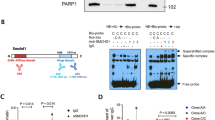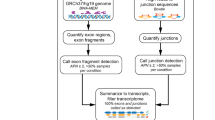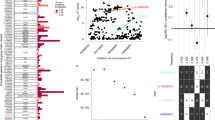Abstract
Cytotoxic T-lymphocyte-associated protein 4 (CTLA4) is a protein receptor that downregulates the immune system. CTLA4 gene variants associate with various autoimmune diseases, including type 1 diabetes. Fine mapping of the genetic risk has shown that the genomic region near CTLA4 marked by the single-nucleotide polymorphism (SNP) CT60A/G (rs3087243) acts as a susceptibility factor. Yet, the functional basis for the increased susceptibility conferred by rs3087243 remains unclear. We demonstrate that the length of the dinucleotide (AT)n repeat within the CTLA4 3’ untranslated region (3′UTR) strongly associates with the risk of SNP CT60A/G (P<6.5 × 10−72). Genomic (AT)n repeat length inversely correlated with CTLA4 messenger RNA (mRNA) and protein levels in islet autoreactive T-cell lines. Transfer of a long (AT)n element into T cells lead to a reduction of mRNA compared to a short (AT)n element. Thus, this study provides evidence for a role of the CTLA4 3′UTR (AT)n repeat in the increased genetic risk for islet autoimmunity associated with the CTLA4 locus.
This is a preview of subscription content, access via your institution
Access options
Subscribe to this journal
Receive 6 digital issues and online access to articles
$119.00 per year
only $19.83 per issue
Buy this article
- Purchase on Springer Link
- Instant access to full article PDF
Prices may be subject to local taxes which are calculated during checkout


Similar content being viewed by others
References
Harding FA, McArthur JG, Gross JA, Raulet DH, Allison JP . CD28-mediated signalling co-stimulates murine T cells and prevents induction of anergy in T-cell clones. Nature 1992; 356: 607–609.
Koulova L, Clark EA, Shu G, Dupont B . The CD28 ligand B7/BB1 provides costimulatory signal for alloactivation of CD4+ T cells. J Exp Med 1991; 173: 759–762.
Krummel MF, Allison JP . CD28 and CTLA-4 have opposing effects on the response of T cells to stimulation. J Exp Med 1995; 182: 459–465.
Ise W, Kohyama M, Nutsch KM, Lee HM, Suri A, Unanue ER et al. CTLA-4 suppresses the pathogenicity of self antigen-specific T cells by cell-intrinsic and cell-extrinsic mechanisms. Nat Immunol 2010; 11: 129–135.
Wing K, Onishi Y, Prieto-Martin P, Yamaguchi T, Miyara M, Fehervari Z et al. CTLA-4 control over Foxp3+ regulatory T cell function. Science 2008; 322: 271–275.
Qureshi OS, Zheng Y, Nakamura K, Attridge K, Manzotti C, Schmidt EM et al. Trans-endocytosis of CD80 and CD86: a molecular basis for the cell-extrinsic function of CTLA-4. Science 2011; 332: 600–603.
Orban T, Bundy B, Becker DJ, DiMeglio LA, Gitelman SE, Goland R et al. Co-stimulation modulation with abatacept in patients with recent-onset type 1 diabetes: a randomised, double-blind, placebo-controlled trial. Lancet 2011; 378: 412–419.
Barrett JC, Clayton DG, Concannon P, Akolkar B, Cooper JD, Erlich HA et al. Genome-wide association study and meta-analysis find that over 40 loci affect risk of type 1 diabetes. Nat Genet 2009; 41: 703–707.
Smyth DJ, Plagnol V, Walker NM, Cooper JD, Downes K, Yang JH et al. Shared and distinct genetic variants in type 1 diabetes and celiac disease. N Engl J Med 2008; 359: 2767–2777.
Stahl EA, Raychaudhuri S, Remmers EF, Xie G, Eyre S, Thomson BP et al. Genome-wide association study meta-analysis identifies seven new rheumatoid arthritis risk loci. Nat Genet 2010; 42: 508–514.
Rueda B, Zhernakova A, Lopez-Nevot MA, Gomez-Garcia M, Ortega E, Pinero A et al. CTLA4/CT60 polymorphism is not relevant in susceptibility to autoimmune inflammatory intestinal disorders. Hum Immunol 2005; 66: 321–325.
Chen Z, Brant SR, Li C, Shrestha UK, Jiang T, Zhou F et al. CTLA4 -1661A/G and 3'UTR long repeat polymorphisms are associated with ulcerative colitis and influence CTLA4 mRNA and protein expression. Genes Immun 2010; 11: 573–583.
Zhernakova A, Eerligh P, Barrera P, Wesoly JZ, Huizinga TW, Roep BO et al. CTLA4 is differentially associated with autoimmune diseases in the Dutch population. Hum Genet 2005; 118: 58–66.
Ligers A, Teleshova N, Masterman T, Huang WX, Hillert J . CTLA-4 gene expression is influenced by promoter and exon 1 polymorphisms. Genes Immun. 2001; 2: 145–152.
Ueda H, Howson JM, Esposito L, Heward J, Snook H, Chamberlain G et al. Association of the T-cell regulatory gene CTLA4 with susceptibility to autoimmune disease. Nature 2003; 423: 506–511.
Hao S, Baltimore D . The stability of mRNA influences the temporal order of the induction of genes encoding inflammatory molecules. Nat Immunol 2009; 10: 281–288.
Anderson P . Post-transcriptional control of cytokine production. Nat Immunol 2008; 9: 353–359.
de Jong VM, Zaldumbide A, van der Slik AR, Persengiev SP, Roep BO, Koeleman BP . Post-transcriptional control of candidate risk genes for type 1 diabetes by rare genetic variants. Genes Immun 2013; 14: 58–61.
Morahan G, Huang D, Ymer SI, Cancilla MR, Stephen K, Dabadghao P et al. Linkage disequilibrium of a type 1 diabetes susceptibility locus with a regulatory IL12B allele. Nat Genet 2001; 27: 218–221.
Roep BO, Kallan AA, Hazenbos WL, Bruining GJ, Bailyes EM, Arden SD et al. T-cell reactivity to 38 kD insulin-secretory-granule protein in patients with recent-onset type 1 diabetes. Lancet 1991; 337: 1439–1441.
Lindstein T, June CH, Ledbetter JA, Stella G, Thompson CB . Regulation of lymphokine messenger RNA stability by a surface-mediated T cell activation pathway. Science 1989; 244: 339–343.
Gough SC, Walker LS, Sansom DM . CTLA4 gene polymorphism and autoimmunity. Immunol Rev 2005; 204: 102–115.
Mayans S, Lackovic K, Nyholm C, Lindgren P, Ruikka K, Eliasson M et al. CT60 genotype does not affect CTLA-4 isoform expression despite association to T1D and AITD in northern Sweden. BMC Med Genet 2007; 8: 3.
Purohit S, Podolsky R, Collins C, Zheng W, Schatz D, Muir A et al. Lack of correlation between the levels of soluble cytotoxic T-lymphocyte associated antigen-4 (CTLA-4) and the CT-60 genotypes. J Autoimmune Dis 2005; 2: 8.
Atabani SF, Thio CL, Divanovic S, Trompette A, Belkaid Y, Thomas DL et al. Association of CTLA4 polymorphism with regulatory T cell frequency. Eur J Immunol 2005; 35: 2157–2162.
Esposito L, Hunter KMD, Clark J, Rainbow DB, Stevens H, Denesha J et al. Investigation of Soluble and Transmembrane CTLA-4 Isoforms in Serum and Microvesicles. J Immunol 2014; 193: 889–900.
Vijayakrishnan L, Slavik JM, Illes Z, Greenwald RJ, Rainbow D, Greve B et al. An autoimmune disease-associated CTLA-4 splice variant lacking the B7 binding domain signals negatively in T cells. Immunity 2004; 20: 563–575.
Araki M, Chung D, Liu S, Rainbow DB, Chamberlain G, Garner V et al. Genetic evidence that the differential expression of the ligand-independent isoform of CTLA-4 is the molecular basis of the Idd5.1 type 1 diabetes region in nonobese diabetic mice. J Immunol 2009; 183: 5146–5157.
Gu M, Kakoulidou M, Giscombe R, Pirskanen R, Lefvert AK, Klareskog L et al. Identification of CTLA-4 isoforms produced by alternative splicing and their association with myasthenia gravis. Clin Immunol 2008; 128: 374–381.
Dudbridge F . Likelihood-based association analysis for nuclear families and unrelated subjects with missing genotype data. Hum Hered 2008; 66: 87–98.
Acknowledgements
This work was funded by grants from the Dutch Diabetes Research Foundation, the ZonMW VICI program, The Juvenile Diabetes Research Foundation, The Leiden University Medical Center and the 7th Framework Program of the European Commission.
Author information
Authors and Affiliations
Corresponding author
Ethics declarations
Competing interests
The authors declare no conflict of interest.
Additional information
Supplementary Information accompanies this paper on Genes and Immunity website
Rights and permissions
About this article
Cite this article
de Jong, V., Zaldumbide, A., van der Slik, A. et al. Variation in the CTLA4 3′UTR has phenotypic consequences for autoreactive T cells and associates with genetic risk for type 1 diabetes. Genes Immun 17, 75–78 (2016). https://doi.org/10.1038/gene.2015.51
Received:
Revised:
Accepted:
Published:
Issue Date:
DOI: https://doi.org/10.1038/gene.2015.51
This article is cited by
-
High-yield genome engineering in primary cells using a hybrid ssDNA repair template and small-molecule cocktails
Nature Biotechnology (2023)
-
The heterogeneous pathogenesis of type 1 diabetes mellitus
Nature Reviews Endocrinology (2019)
-
Message from the new Editors-in-Chief
Genes & Immunity (2019)
-
Evolutionary and functional implications of 3′ untranslated region length of mRNAs by comprehensive investigation among four taxonomically diverse metazoan species
Genes & Genomics (2019)
-
Genetic Mechanisms Highlight Shared Pathways for the Pathogenesis of Polygenic Type 1 Diabetes and Monogenic Autoimmune Diabetes
Current Diabetes Reports (2019)



